Takeaways
Lessons and outcome.
Over communication is key
I felt that I gained valuable insights into our technical possibilities or limitations. This helped in implementing practical designs.
Design systems are crucial
Through consistent framework of reusable components and guidelines we streamlined the design and development process. We were able to accelerate development cycles, reduce errors, and ensure that the end product meets technical standards effectively.
Improved filter/facet tree: Features an inline product search through
taxonomy organization and design consistencies.
Inline search: Features include unique search options based on keywords and characters and search tips.
Visual and interactive design: Features design system alignment, device population style, hover design, “Show more” CTA loading.
Navigation: Breadcrumb clean-up, URL redirects, Device Finder call-outs.
Summary
Launch results
The enhanced device finder component
was published on April 14, 2023. The enhancements that launched, included
or resulted in:
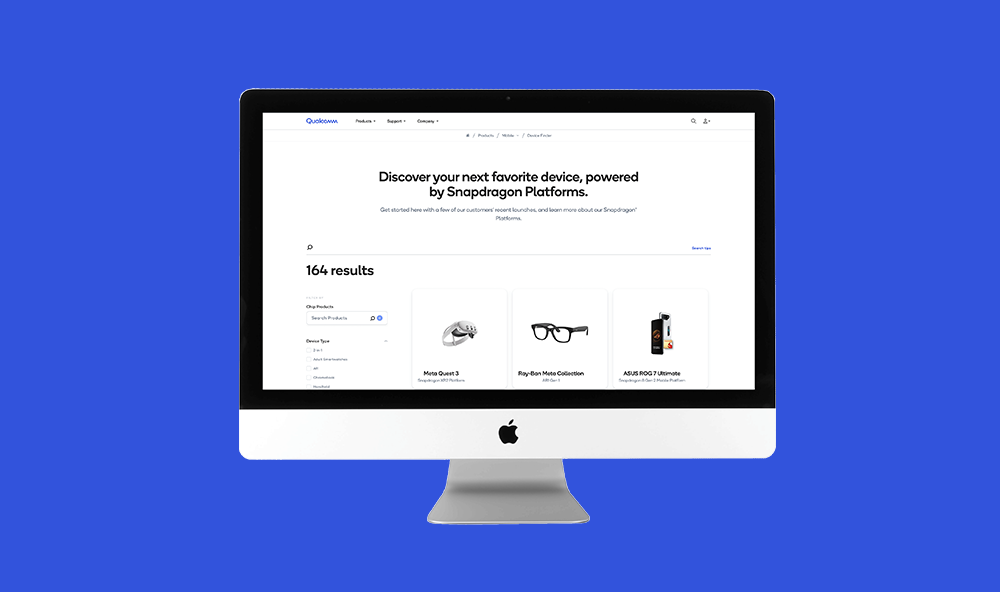
Final, redesigned, device finder
Filter trees
The filter tree copy, expand/collapse, product search, and semantics changed based on common device attributes. The visual design aligns with existing filter tree options across QC.com finders.



Search
The inline search option was a net-new addition to the device finder. The visual design aligns with existing search options across QC.com finders.
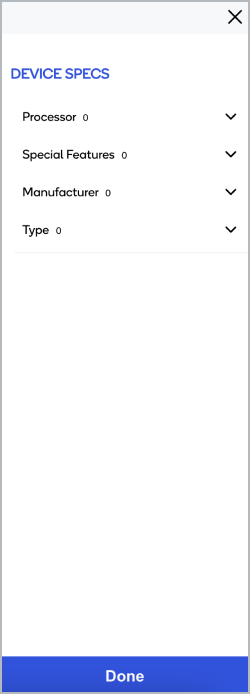
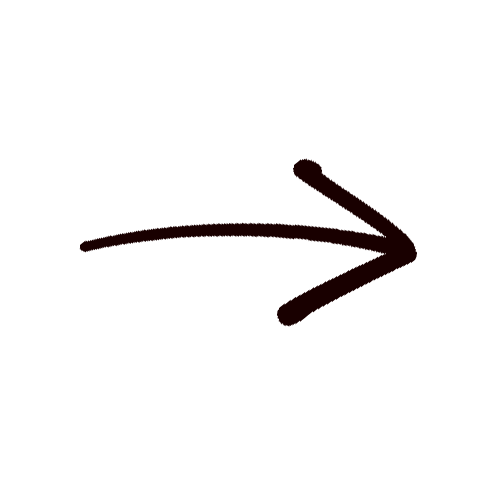
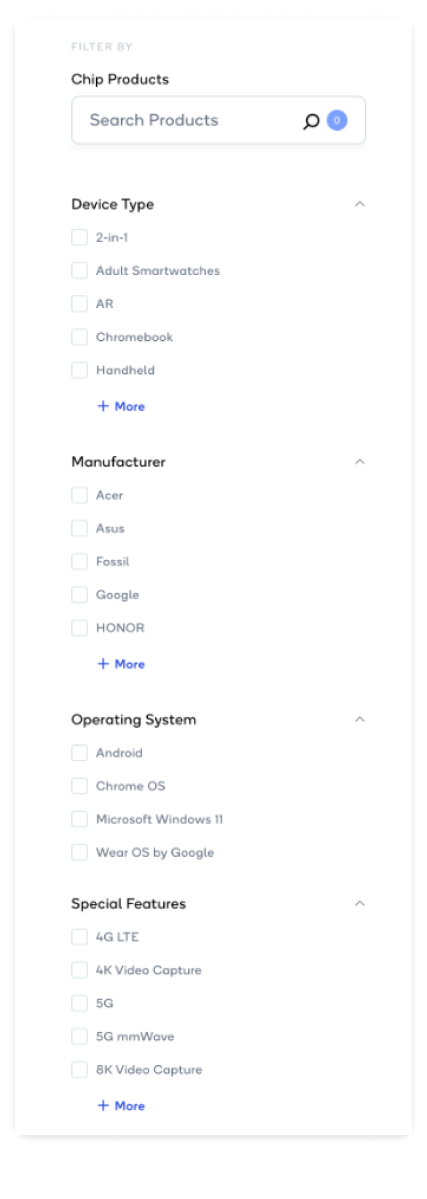
Device atoms
Applied drop shadow, removed border and background color, and animation.
The visual design aligns with existing finder atoms across QC.com finders.
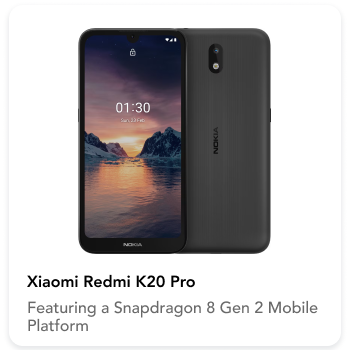

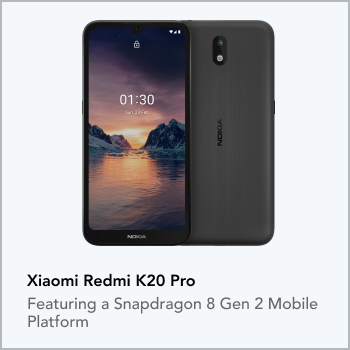
Design system alignment
Visual design changes.
The visual design updates were a simple step considering we had existing finders, to reference, on the website. Since the device finder was a component with preset styling, all we needed to do was collaborate with the development team to integrate styling changes.
Check out the finished product here!

How do we get users to the finder
Promo on high traffic pages.
The only way to navigate to the device finder was through our global search or deeply layered into the main navigation. By calling out devices, on this Snapdragon page for example, we were able to convert 13% of Snapdragon landing page visitors
Comparison takeaways
Moving forward with data comparison.
These comparisons helped our team understand what users are seeing across market competitor websites and how we can keep up with present, or forecast future, trends. This includes the below.
- General inline search option: Query handling would allow users to search based on keywords, character, and numeric values.
- Product inline search option: The device finder is a tool used to search for OEM devices. A product finder would allow users to search for their favorite Qualcomm products, then match them with a device that fits their needs.
- Advanced filtering options: Device finder, queried url distribution could result in user accessibility for certain programs (eg. Snapdragon Insiders newsletters).
- Finder discoverability: Building finders by type and distributing visibility across Qualcomm.com.
GOAL statement
Solution proposal
Qualcomm’s Device Finder will allow users to search for their favorite product integrations. Hopefully this change will positively affect our users by allowing search flexibility. We will measure effectiveness by tracking the number of visitors 1 month post launch,
and ongoing measurement afterwards.
Competitor Analysis
Scoping finders,
across the market.
Prior to the Qualcomm Device finder transformation, we needed to see where we stood within the market of tech tools similar to this one. Through market comparison we could identify where we were might be leaving our users at a roadblock.
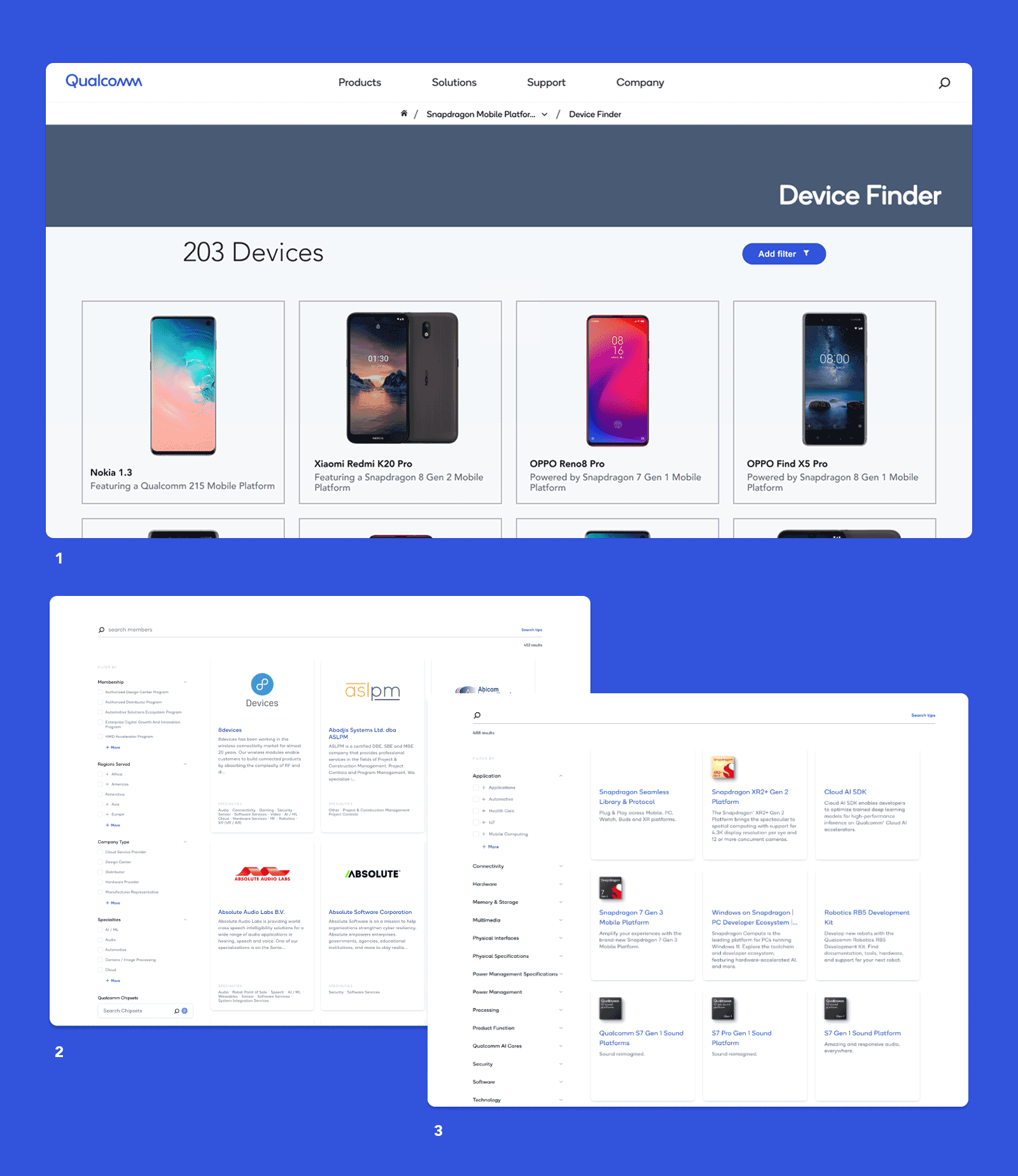
(1) Former device finder
(2) Current, and former, SW & Services finder
(3) Current, and former, Product finder
Visual analysis
How do existing device finders compare on QC.com?
There are currently 402 Device, 490 Product, and 458 Services & Software pages that are hosted on the Qualcomm website. All three of these categories are organized into 3 library types (with exception to sub-types).
The visual design of the device finder lacked, in alignment and functionality, in comparison to the product and partner finders on the website. This design system alignment was considered, when gathering research results.
User personas who would ideally fit the user type.
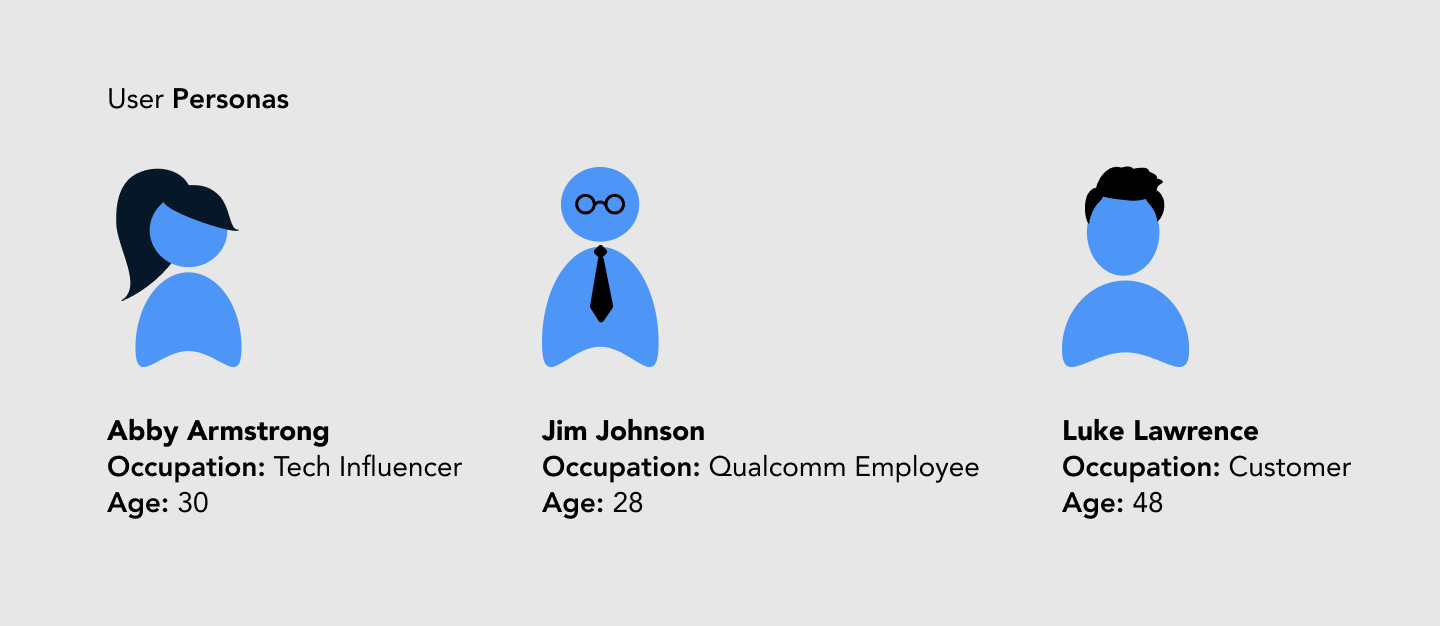
Persona exploration
Who is searching for devices on QC.com and why?
We decided to build stories that revolved around the ideal user who would be using the device finder as a tool. The personas then helped us gather key user characteristics and needs. Through prioritizing these attributes we were able to define design goals based on their needs.
Getting Started
Value proposition questions:
- Who is searching for devices on the Qualcomm website?
- What does the product do for the user? Why should the user care?
- Which companies, within the semiconductor or technology market, are using finders as a tool for their users to leverage?
Puzzling together
the research.
Initial user flow
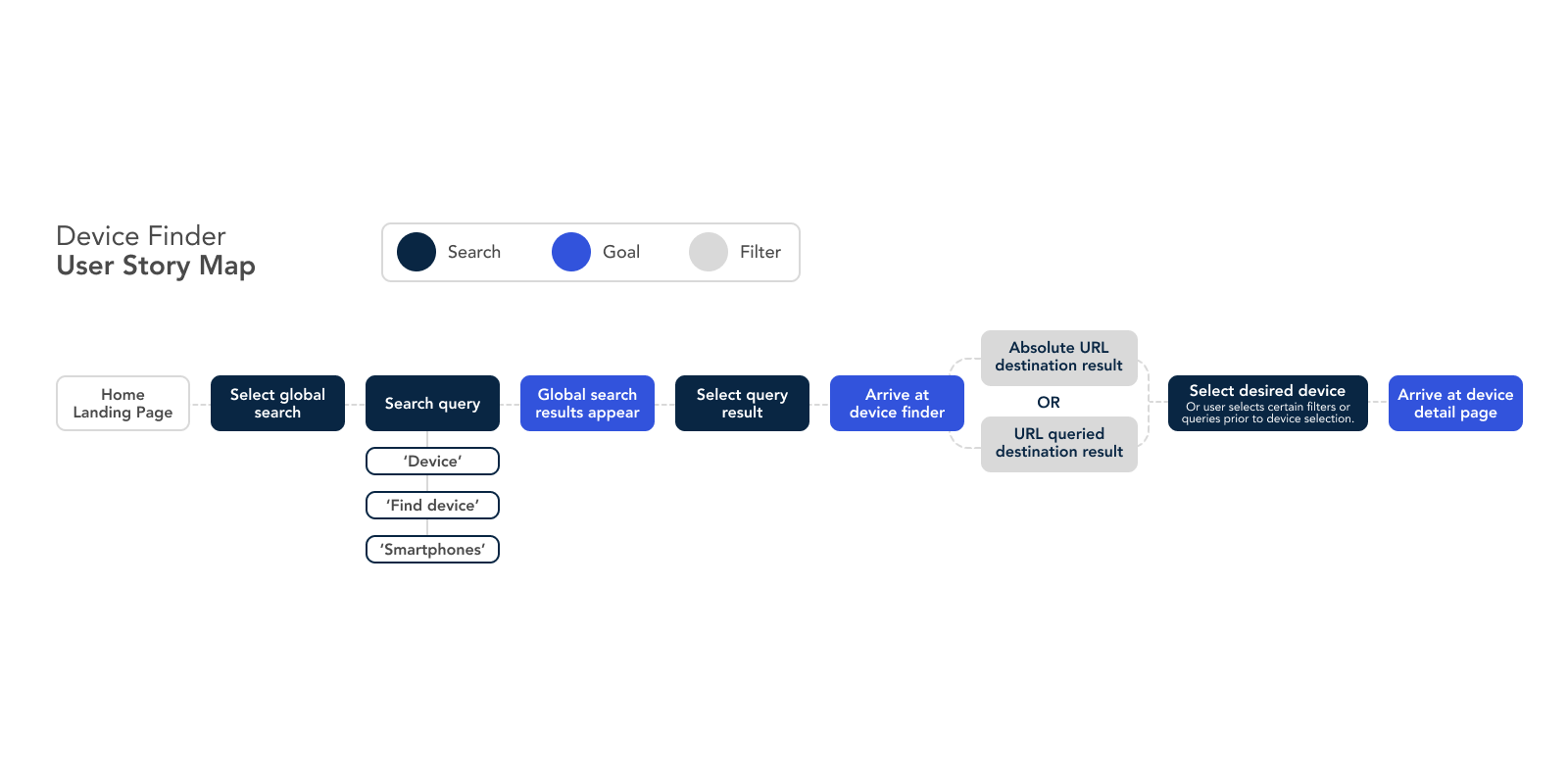
The Challenge
Perfecting the
finder experience.
Qualcomm called the world wide web, home, in May of 1997. Many people did not know who they were or what they had to offer to the tech world. As a semiconductor for smartphones at the time, they needed a way to showcase their products. From mobile processors to chipsets, Qualcomm was making products to power devices. The only question was, what kinds?
Fast forward a few years… the device finder was born. A place for users to search for devices that met their needs and specification desires. Since Qualcomm’s launch to www, many additional products have been created to support an array of devices.
Back

The issues we found included:
- Tool discoverability
- Lack of tool flexibility
- Design inconsistencies
The device finder component exists on the site “by type”. For example, if a
user wants to purchase the newest device that uses Qualcomm’s latest Mobile Processor, they would navigate to the smartphone finder etc. However, we learned that users were unable to search for certain devices as previously expected.
In addition to the tool discoverability level, the finder’s visual experience was flawed. On the front end, the device finder’s visual design was not aligning with Qualcomm’s design system. Lastly, the taxonomy was organized poorly, via content management system tagging, and resulted in a poor filtering experience to the user.
Role: UX Designer
Timeline: Jan - Apr 2023
Teams: Design, Marketing,
Development, Web Ops
UX Design, Design System Alignment, UAT, Research
This case study showcases a comprehensive UX redesign of Qualcomm's Device Finder that transformed a basic device library into an intuitive product discovery platform, achieving a 13% conversion rate within the first month.
Transforming a buried product library into a discoverable search tool.
Qualcomm Device Finder Redesign
Impact
Qualcomm’s improved Device Finder site makes it easier to find out which Snapdragon processor is powering your phone.
13% conversion
from Snapdragon landing page to Device Finder
~60 daily visitors
within first month post-launch
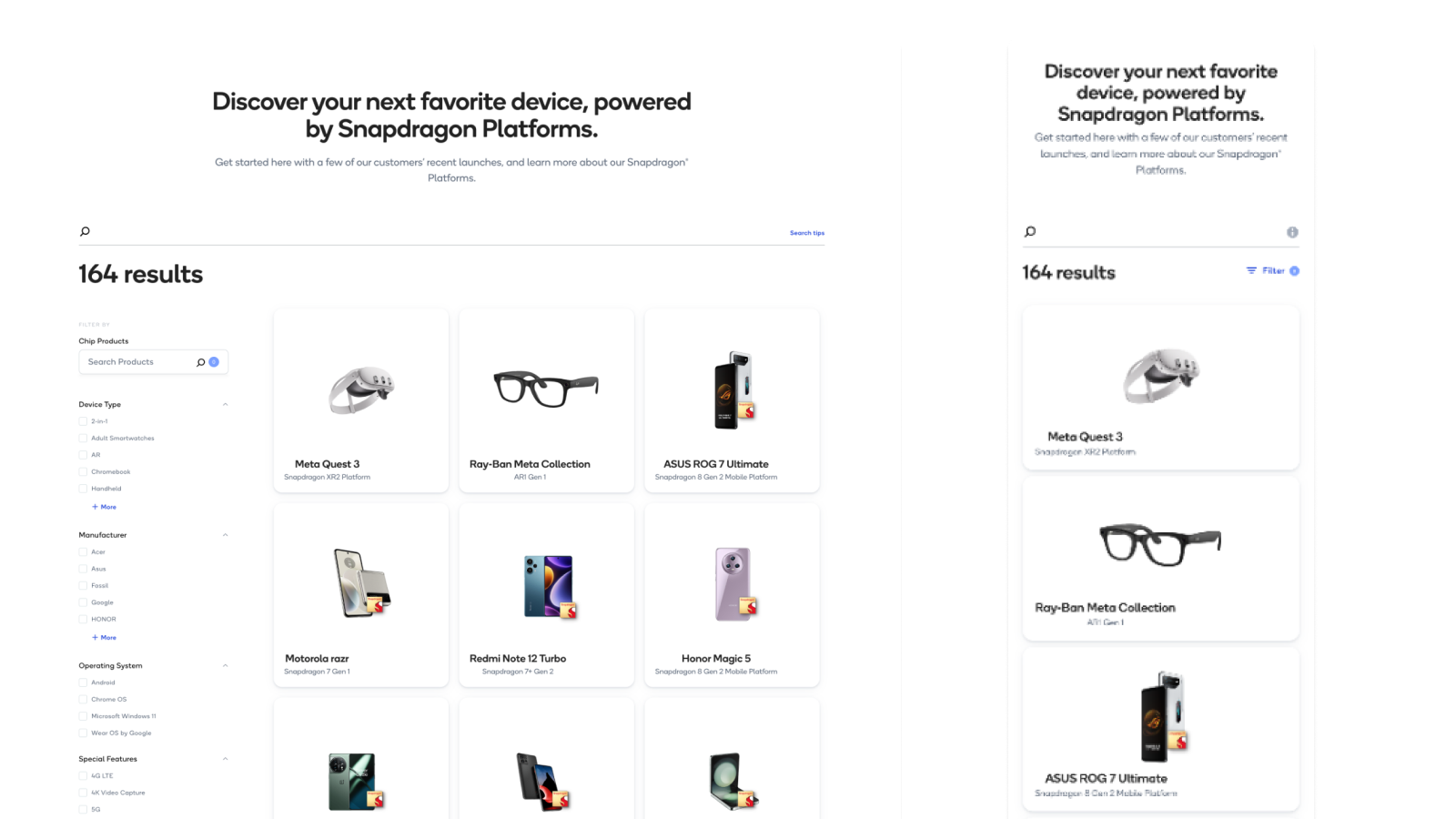

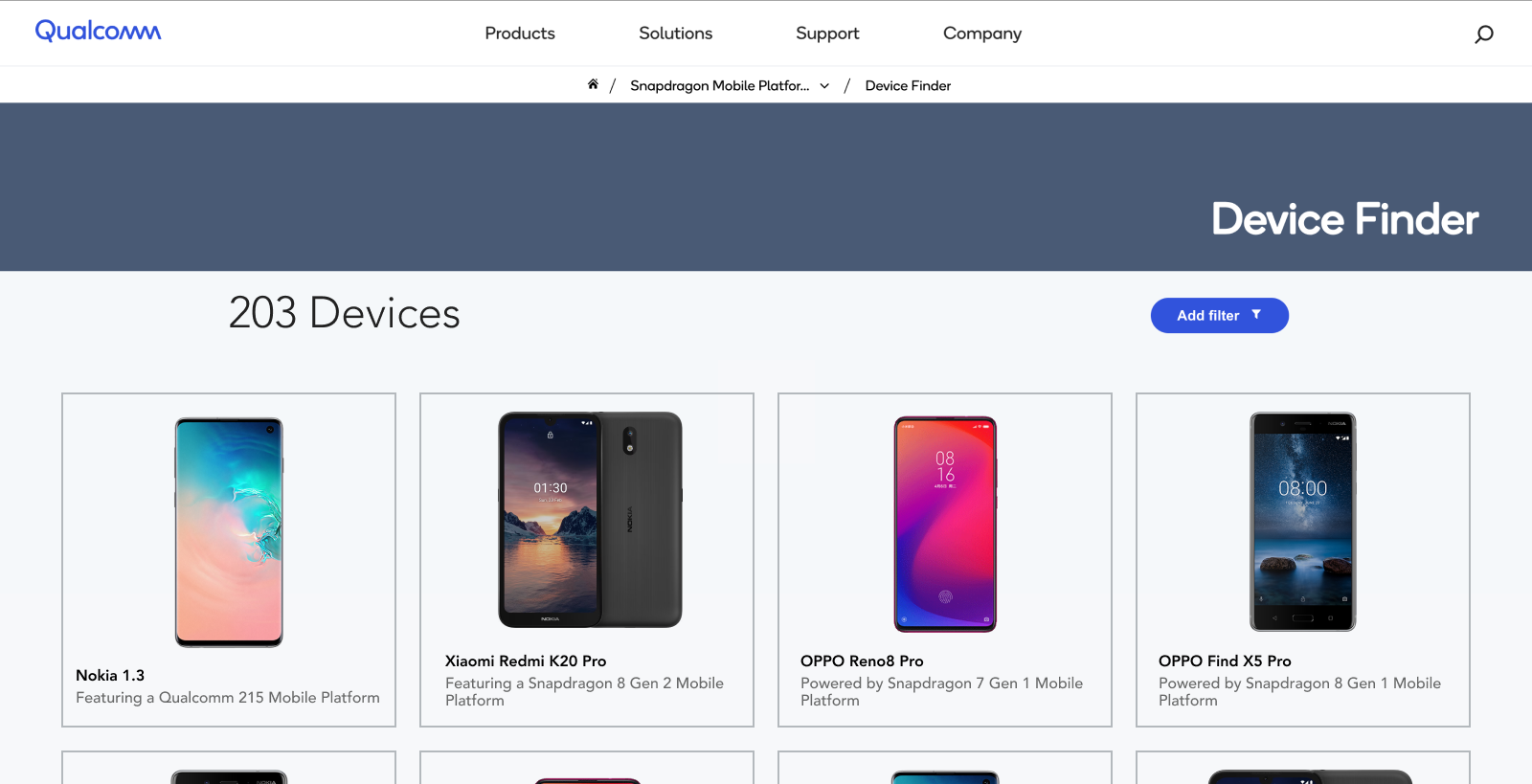


Role: UX Designer
Timeline: Jan - Apr 2023
Teams: Design, Marketing, Development, Web Ops
Transforming a buried product library into a discoverable search tool.
Qualcomm Device Finder Redesign
UX Design, Design System Alignment, UAT, Research
This case study showcases a comprehensive UX redesign of Qualcomm's Device Finder that transformed a basic device library into an intuitive product discovery platform, achieving a 13% conversion rate within the first month.
Competitor Analysis
Scoping finders, across the market
Prior to the Qualcomm Device finder transformation, we needed to see where we stood within the market of tech tools similar to this one. Through market comparison we could identify where we were might be leaving our users at a roadblock.
The Challenge
Perfecting the finder experience.
Qualcomm called the world wide web, home, in May of 1997. Many people did not know who they were or what they had to offer to the tech world. As a semiconductor for smartphones at the time, they needed a way to showcase their products. From mobile processors to chipsets, Qualcomm was making products to power devices. The only question was, what kinds?
Fast forward a few years… the device finder was born. A place for users to search for devices that met their needs and specification desires. Since Qualcomm’s launch to www, many additional products have been created to support an array of devices.
Persona exploration
Who is searching for devices on QC.com and why.
We decided to build stories that revolved around the ideal user who would be using the device finder as a tool. The personas then helped us gather key user characteristics and needs. Through prioritizing these attributes we were able to define design goals based on their needs.


(1) Former device finder
(2) Current, and former, SW & Services finder
(3) Current, and former, Product finder
Comparison takeaways
Moving forward with data comparison.
These comparisons helped our team understand what users are seeing across market competitor websites and how we can keep up with present, or forecast future, trends. This includes the below.
- General inline search option: Query handling would allow users to search based on keywords, character, and numeric values.
- Product inline search option: The device finder is a tool used to search for OEM devices. A product finder would allow users to search for their favorite Qualcomm products, then match them with a device that fits their needs.
- Advanced filtering options: Device finder, queried url distribution could result in user accessibility for certain programs (eg. Snapdragon Insiders newsletters).
- Finder discoverability: Building finders by type and distributing visibility across Qualcomm.com.
GOAL statement
Solution proposal
Qualcomm’s Device Finder will allow users to search for their favorite product integrations. Hopefully this change will positively affect our users by allowing search flexibility. We will measure effectiveness by tracking the number of visitors
1 month post launch, and ongoing measurement afterwards.

Final, redesigned, device finder
Improved filter/facet tree: Features an inline product search through
taxonomy organization and design consistencies.
Inline search: Features include unique search options based on keywords and characters and search tips.
Visual and interactive design: Features design system alignment, device population style, hover design, “Show more” CTA loading.
Navigation: Breadcrumb clean-up, URL redirects, Device Finder call-outs.

Initial user flow
Summary
Launch results
The enhanced device finder component was published on April 14, 2023. The enhancements that launched, included or resulted in:
Takeaways
Lessons and outcome.
Over communication is key
I felt that I gained valuable insights into our technical possibilities or limitations. This helped in implementing practical designs.
Design systems are crucial
Through consistent framework of reusable components and guidelines we streamlined the design and development process. We were able to accelerate development cycles, reduce errors, and ensure that the end product meets technical standards effectively.
Check out the finished product here!
How do we get users to the finder
Promo on high traffic pages.
The only way to navigate to the device finder was
through our global search or deeply layered into the main navigation. By calling out devices, on this Snapdragon page for example, we were able to convert 13% of Snapdragon landing page visitors
Visual analysis
How do existing device finders compare on QC.com?
There are currently 402 Device, 490 Product, and 458 Services & Software pages that are hosted on the Qualcomm website. All three of these categories are organized into 3 library types (with exception to sub-types).
The visual design of the device finder lacked, in alignment and functionality, in comparison to the product and partner finders on the website. This design system alignment was considered, when gathering research results.
Back to all work



Search
The inline search option was a net-new addition to the device finder. The visual design aligns with existing search options across QC.com finders.



The filter tree copy, expand/collapse, product search, and semantics changed based on common device attributes. The visual design aligns with existing filter tree options across QC.com finders.
Filter trees
Device atoms
Applied drop shadow, removed border and background color, and animation.
The visual design aligns with existing finder atoms across QC.com finders.



Design system alignment
Visual design changes.
The visual design updates were a simple step considering we had existing finders, to reference, on the website. Since the device finder was a component with preset styling, all we needed to do was collaborate with the development team to integrate styling changes.
Getting Started
Value proposition questions:
- Who is searching for devices on the Qualcomm website?
- What does the product do for the user? Why should the user care?
- Which companies, within the semiconductor or technology market, are using finders as a tool for their users to leverage?
Puzzling together the research.

The issues we found included:
- Tool discoverability
- Lack of tool flexibility
- Design inconsistencies
The device finder component exists on the site “by type”. For example, if a
user wants to purchase the newest device that uses Qualcomm’s latest Mobile Processor, they would navigate to the smartphone finder etc. However, we learned that users were unable to search for certain devices as previously expected.
In addition to the tool discoverability level, the finder’s visual experience was flawed. On the front end, the device finder’s visual design was not aligning with Qualcomm’s design system. Lastly, the taxonomy was organized poorly, via content management system tagging, and resulted in a poor filtering experience to the user.
I’d love to help build your next project. Ready when you are, say hi.
“
Impact
Qualcomm’s improved Device Finder site makes it easier to find out which Snapdragon processor is powering your phone.
13% conversion
from Snapdragon landing page to Device Finder
~60 daily visitors